Charlie Moores, Birds Korea Network: March 2004
Wetlands worldwide are faced with degradation and destruction.
Although key to fisheries and water resources and critical for the maintenance of life and biodiversity, wetlands continue to be undervalued and “lost”. Long-term this loss of wetland and wetland function threatens wildlife and human life on a huge scale. In the short term, the destruction of one of the world's greatest estuaries, the Saemangeum estuarine system in South Korea, will rob the world of extraordinary beauty, degrade our lives and our environment, and contribute to the imminent extinction of one of the planet's most charismatic bird species - the Siberian-nesting Spoon-billed Sandpiper.
With these thoughts in mind, and following the domestic impact of a huge and culturally symbolic samboilbae (go to “three steps and one bow”) walk in Korea, the Birds Korea Network proposed the organisation of a coordinated international samboilbae, to both mark the Ramsar Convention-organized World Wetlands Day*, and to draw attention to threats to wetlands in Korea and beyond.
(*“WWD” has been held annually since 1997: go to www.ramsar.org/wwd2004 index)
Nial Moores discussed the concept with colleagues in Korea, and suggested that if a high-profile Korean activist or spiritual leader could come to the UK to take part in the samboilbae, the event would be both more culturally-authentic and more "media-friendly". He began talks with the Korean Federation for Environmental Movement (KFEM)'s international section, and it was agreed that KIM SuKyung would accompany a still to be named Korean spiritual leader to the UK in the role of wetland activist and of translator.
As the plans developed, it became increasingly obvious that if high-profile Korean activists were going to be travelling overseas, there would be an unmissable chance of bringing them together with activists in the UK to discuss Saemangeum and promote international co-operation - and to gain valuable experience of different wetland systems and bird reserves. At the same time we agreed that Charlie Moores of Birds Korea (as well as being responsible for the organisation and itinerary of the UK part of the trip) would accompany the group at all times and be a full part of any discussions that took place.
This idea was enthusiastically taken up, and in a remarkably short time - and with the help particularly of Dr Baz Hughes of Wildfowl and Wetlands Trust (WWT) , Dr Richard Thomas of BirdLife International, and Steve Rowland of the Royal Society for the Protection of Birds (RSPB) and the Oriental Bird Club - a provisional itinerary of meetings was set up with some of the UK's leading conservationists - including CEOs and department heads of WWT, BirdLife, the RSPB, The Whale and Dolphin Conservation Society (WDCS), and Friends of the Earth (FoE).
As the schedule for these meetings evolved and became fixed, enthusiasm and interest within Korea rose, and just two weeks before the samboilbae in the UK was due to take place the participating Korean group had swelled to five.
The result was the visit to the UK in late-January of three of Korea's most prominent spiritual leaders, the Revs Su-Kyung, Do-boep, and LEE Seon-jong (see below), MA Yong-un of KFEM, and KIM SuKyung. Likely long-term benefits of this visit were increased by the generous offer of Werner Mueller of BirdLife Swiss partner SVS/ASPO (go to SVS/ASPO), who had met Nial Moores in Korea on a Guided Tour, to contribute to the costs of a visit to Switzerland by members of the group to participate in a samboilbae at the Ramsar site of La Sauge, Lac Neutachel. Werner also organised a crucially-important presentation and meeting at the Ramsar Convention Bureau's headquarters in Geneva with the Bureau's Senior Advisor for the Asia-Pacific, Dr. Lei Gaungchun.
The following article looks back at we hope will be a hugely important week for Korean conservation, and re-iterates that the Birds Korea Network remains both proud and dedicated to continue spreading the message of those who are opposed to this catastrophic, wholly damaging and unnecessary reclamation...
Nial Moores, Birds Korea, 2004
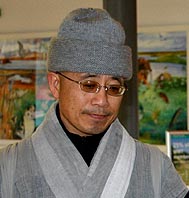 | Rev. Su-kyung is one of four religious leaders who lead 2003's Korean Samboilbae. He became involved in the Buddhist environmental movement in 2000, influenced by one of his closest friends, the Rev. Do-beop. He founded the Buddhist Environmental Alliance, is a co-president of the Saemangeum Life and Peace Alliance, and has lead many environmental campaigns. Rev. Su-kyung is a zen master of the Silsang-sa Temple on Jirisan mountain in southern Korea, and with others who lead the Samboilbae was awarded many prizes last year from environmental groups and the media. |
| Rev. Do-beop is head master of Silsang-sa Temple, one of the oldest Buddhist temples in Korea. He has been leading the Buddhism purification movement in Korea, asking Buddhists to return to the pure and original teachings of Buddha, for about 20 years. He has founded a number of Buddhist environmental organizations (including Jirisan Life and Peace Alliance) and is one of the most respected living Buddhist monks in Korea. He was selected as one of the 100 "next generation leaders of Korea" (the only one from Buddhist society) by the Hankyoreh, a Korean national daily newspaper in Jan 2004. | 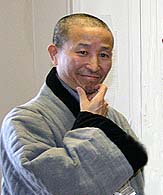 |
 | Rev. Lee Seon-Jong is a highly respected nun of Won-bul-gyo (or Won Buddhism) and a past head master of Jongno Wonbulgyo Temple in Seoul. She is one of the co-presidents of the Saemangeum Life and Peace Alliance, and founded, and has been president of, Cheon-ji-bo-eun-hoi, a Wonbuddhist environmental group. She is considered to be one of the most respected living Wonbuddhist monks and nuns in Korea, and with Rev Do-beop was also selected as one of 100 "next generation leaders of Korea" (the only one from Wonbulgyo society) by the Hankyoreh newspaper. |
The party arrived from Korea on January 27th, and after a night's rest the hard work began...
Slimbridge Wildfowl and Wetland Centre
Slimbridge:
Located on the internationally-important Severn estuary (Ramsar site no. 737), Slimbridge is the headquarters of the Wildfowl and Wetlands Trust. Sir Peter Scott's vision became a reality at Slimbridge in 1946, when he realised how many thousands of geese depended on the shores of the Severn Estuary.
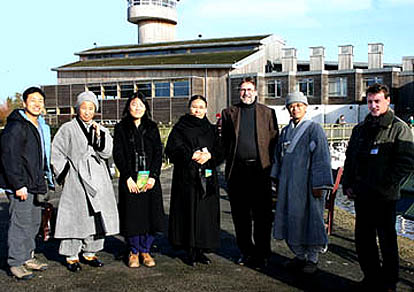
Today with its award-winning visitor centre overlooking nationally and internationally protected wetlands, this world famous site is an important wintering area for migrating waterbirds such as Bewick's Swans, Eurasian Wigeon, and Greater White-fronted Geese. Slimbridge also houses the WWT's species conservation programme. (Go to Slimbridge)
In total, over 4,000 acres are managed by WWT, including seven Sites of Special Scientific Interest (SSSI's), five Special Protection Areas (SPAs) and six Ramsar sites.
In a five-hour visit, both Doug Hulyer and then Dr Baz Hughes showed the Korean party around Slimbridge, explained WWT policy regarding Saemangeum, provided data demonstrating the importance of the Severn Estuary, and expressed WWT's commitment to supporting conservation within Korea.
The group also looked around the captive wildfowl collection, at the structure and location of birdwatching hides, and at how information was laid out in the visitor centre.
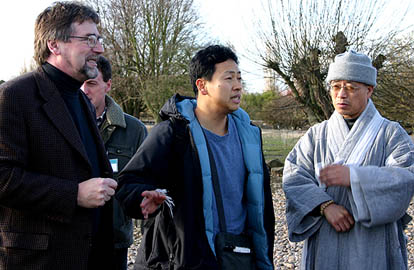
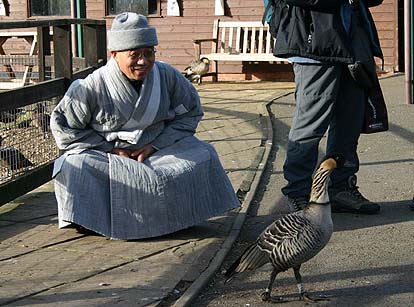
Photo © Charlie Moores/Birds Korea.
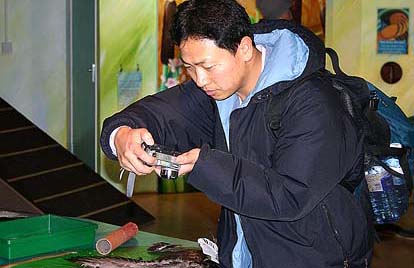
Photo © Charlie Moores/Birds Korea.
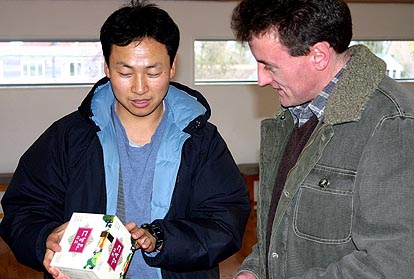
Photo © Charlie Moores/Birds Korea.
Whale and Dolphin Conservation Society (WDCS),
Eco-Prior, Prior Park School, Bath
WDCS:
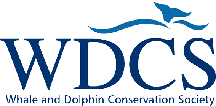
The Whale and Dolphin Conservation Society is dedicated to the conservation and welfare of all whales, dolphins and porpoises and is based in Chippenham, Wiltshire. (Go to WDCS)
Established in 1987, WDCS is staffed by a small, dedicated team of people proud of the fact that WDCS's operating costs are kept to a minimum. The money raised is spent on urgent conservation, research and education projects that really do make a difference to the daily lives and long-term security of thousands of cetaceans around the world.
At an hour-long meeting with WDCS CEO Chris Butler-Stroud and Director of Science Mark Simmonds, Ma Yong-un discussed possible international co-operation and sharing data ahead of the 2005 IWC meeting in Ulsan, South Korea.
EcoPrior:
EcoPrior is a conservation group formed just last year (2003). Led by its energetic and committed founder, Toby Nowlan, the group consists (solely, at the moment) of students at the Prior Park School in Bath.
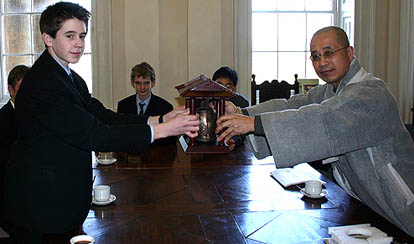
EcoPrior's first campaign has been supporting Birds Korea's work in South Korea - collecting over 4000 signatures for the "Save Saemangeum" petition we ran, and raising almost GBP300 towards the costs of the UK visit of the Rev SuKyung. The group's activities and successes regularly feature on our Saemangeum Reference Page. The group has also launched its own website: Go to EcoYouth.
During a moving meeting, sanctioned by Prior Park Headmaster Dr Giles Mercer, the Korean group praised the efforts of EcoPrior and commented how surprised they had been to learn that students in the UK were so committed to involvement in the fight to save Saemangeum. Helped with translation throughout by Korean Prior Park student SHIN Woo Kang, the students vowed to continue the work they were doing, and were presented with a replica of the Posin-Gak bell - a sign of the respect the spiritual leaders in particular felt for the group's efforts.
The meeting was reported the next day in the Bath Evening Chronicle, accompanied by a large photograph.
(As a postscript, despite discussions with some very prestigious conservationists it was this meeting with EcoPrior that the three Korean spiritual leaders declared to be the most "inspiring" of the week!)
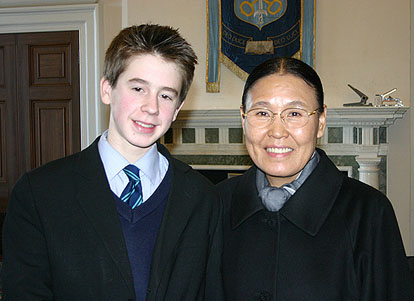
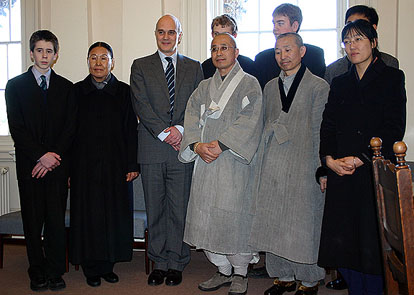
The Lodge, RSPB Headquarters, Beds a.m.
BirdLife International Headquarters, Cambs midday
Welney WWT Reserve, Cambs p.m.
The RSPB:
Formed in 1889, the RSPB has grown into an internationally-important wildlife conservation charity with more than a million members. The organisation currently owns over 150 nature reserves throughout the UK (covering more than 240,000 acres), and since its successful first campaign to end the plumage trade has widened its sphere of influence to include a huge range of issues that affect wildlife and habitats. (Go to RSPB)
Based at The Lodge, in Bedfordshire, the RSPB is the UK partner of BirdLife International.
During a 40 minute meeting, Graham Wynne (RSPB CEO) and International Treaties Advisers John O'Sullivan and David Pritchard discussed possible compromises to the Saemangeum reclamation project, strategies to pursue with regards to the Ramsar Convention, and pledged that the RSPB would continue to offer support to the fight to stop the reclamation altogether by lobbying the Korean Government.
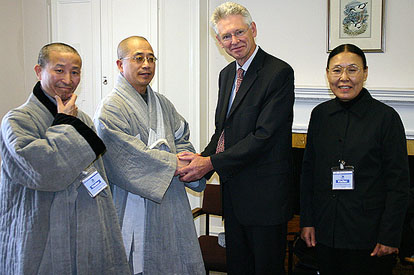
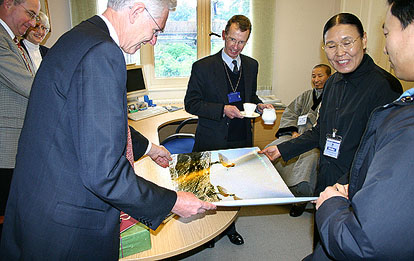
BirdLife International:
BirdLife International is a global Partnership of conservation organisations, based in Cambridge, UK, that strives to conserve birds, their habitats and global biodiversity, working with people towards sustainability in the use of natural resources. (Go to BirdLife)
BirdLife Partners operate in over one hundred countries and territories worldwide.
Notably, though, there is currently no BirdLife partner in South Korea - a situation that needs to be rectified as a matter of urgency.
During a forty minute meeting, BirdLife International CEO Mike Rands stressed the importance of Saemangeum to international bird populations, the need for international co-operation, and BirdLife's total opposition to the reclamation project.
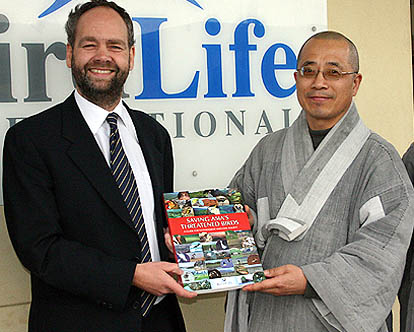
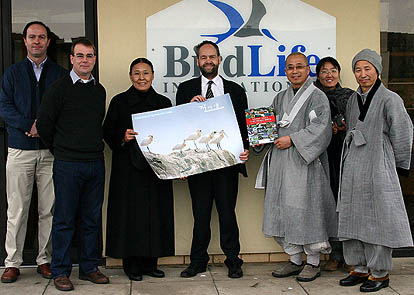
Welney WWT Reserve:
The Ouse Washes, built in the Cambridgeshire Fens, are intensively managed flood-defences extending for 31km. Designed as a flood storage reservoir which acts as a safety valve for flood waters in the Great Ouse catchment, the Washes support huge numbers of wildfowl in the winter.
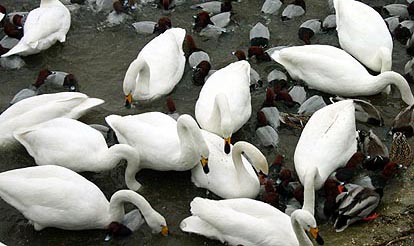
The Welney WWT Reserve is situated at the western end of the Washes, and attracts hundreds of Whooper and Bewick's Swans in the winter, accompanied by flocks of thousands of ducks. During the day, carpets of Wigeon graze this precious wetland, while flocks of Pintail, Teal, Gadwall and Shoveler dabble in the pools and lagoons. Late afternoon is a special time as necks of swans flight-in to claim their night roosting sites: from late October 25th until the end of March, there is a daily grain feed by one of the wardens, with live commentary, at 3.30pm. Go to: Welney WWT.
After meeting Darrell Stevens (WWT Welney Centre Manager), who gave the party an informative talk about the history of the Reserve over some very welcome tea and cakes (see below!), the group went to get stunning close-up views of feeding Bewick's Swans.
A short interview about Saemangeum and Korean conservation was also conducted with both Charlie Moores and Ma Yong-un by BBC local radio.
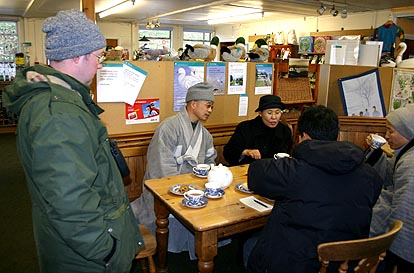
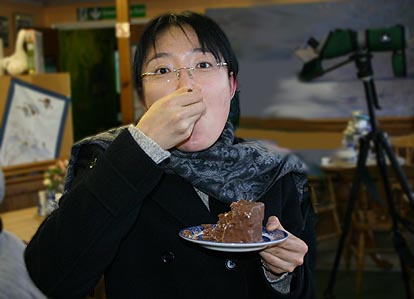
UK Samboilbae, Snettisham RSPB Reserve a.m.
Holme Dunes NNT, p.m.
"Of the many beautiful and important places for wildlife in Korea there is one that particularly stands out - Saemangeum. Of the many struggles that Korean people have undertaken in Saemangeum's name, none is as moving or so purely motivated as the gruelling sambolibae, a ritual walk that perfectly represents the deeply-felt spiritual opposition to this spiritually-bereft reclamation - the mindless destruction of one of the "Green Star's" most vital wetlands."
Charlie Moores, Birds Korea, 2004.
Snettisham:
The RSPB's Snettisham nature reserve is situated on the Norfolk coast and is part of the protected tidal areas of The Wash, a vast intertidal embayment incorporating one of the largest and most important areas of estuarine mudflats, sandbanks and saltmarsh in Britain. Counts of wintering waterbirds on The Wash reach 320,673 individuals and include nationally and internationally important numbers of numerous species. The site is also of outstanding international importance for passage birds, notable waders, and supports various breeding birds, an important shell fishery, and the largest breeding colony in Europe of the seal Phoca vitulina. The Wash is designated as Ramsar site no. 395.
Snettisham is famous for its shorebirds: on a big tide as the water covers the vast mudflats of The Wash, tens of thousands of wading birds are pushed off their feeding grounds and onto the roost banks and islands in front of the RSPB hides.
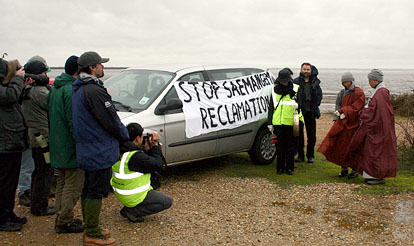
Snettisham was chosen as the site for the samboilbae because it has many parallels with Saemangeum itself - both are areas of international importance for shorebirds because of their tidal flats, and both have been threatened with reclamation (though, of course, Snettisham's future - unlike Saemangeum's - is now secure). Indeed, as the spiritual leaders climbed the shingle bank to view the mudflats for the first time they burst into a spontaneous round of applause so struck were they by how similar the two areas appear.
The entire week's visit, of course, was intended to reach its highlight with the performing of the samboilbae at the RSPB's Snettisham Reserve: unfortunately, the terrible weather literally put a dampener on this unique event, but for those who did manage to make their way through the storm it will be remembered for a very long time as a deeply involving and moving ceremony...
(Birds Korea would like to thank Steve Rowland for his effort and support in arranging for the samboilbae to take place at Snettisham).
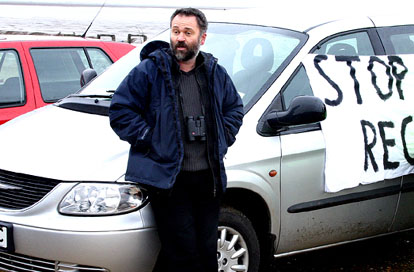
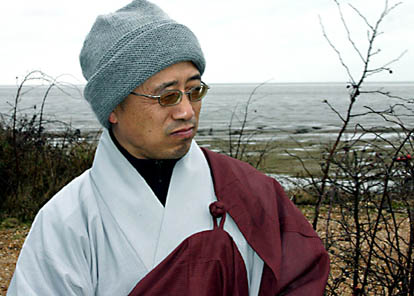
"Mountains, rivers, and oceans have committed no sins. Trees, flowers, wild animals have committed no sins either. It is only the human kind that have committed faults and sins...
...I find my place for discipline not only in the temple and the quiet retreat, but also wherever Nature is being destroyed. Disappearing tidal flats, cruelly maimed mountains, and rotten rivers are the very sites I find my place for repentance."
Rev Su-Kyung, Snettisham, 2004
Read the whole text of Rev Su-kyung's impassioned speech, given before the start of the samboilbae:
Go to samboilbae speech.


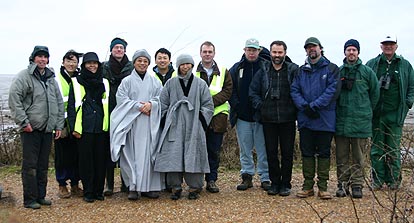
Thornham Beach:
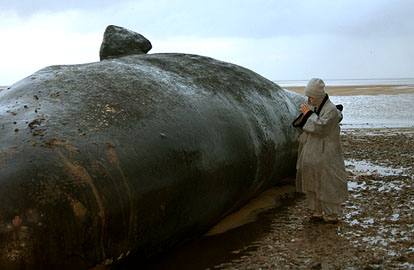
At the samboilbae we were told of a dead male Sperm Whale that had been washed up on the nearby Thornham Beach.
On our arrival, Rev Do-beop strode out across the beach, and - separate from a small crowd of gawping sightseers - touched the carcass and said a short prayer for its spirit: a deeply affecting gesture from a deeply spiritual man.
Ouse Washes, RSPB Reserve
Ouse Washes:
The Ouse Washes, built in the Cambridgeshire Fens, are intensively managed flood-defences extending for 31km. Designed as a flood storage reservoir which acts as a safety valve for flood waters in the Great Ouse catchment, the Washes support huge numbers of wildfowl in the winter.
At the eastern end of The Washes the RSPB owns 983ha (2428 acres) of washland, and works in co-operation with the Cambridgeshire Wildlife Trust which owns another 184ha (456 acres). As well as protecting the visiting wildfowl, the RSPB is working to revert small areas of arable farmland to flooded pasture to create new breeding habitat for Black-tailed Godwits. Go to: Ouse Washes RSPB .
The entire Ouse Washes are listed as Ramsar Site no. 77 (though this designation is currently under Montreux Review).
Ouse Washes Reserve Site Manager Robert Coleman warmly greeted the party, and gave a detailed talk on the history of The Washes, management work on the Reserve, and data of the species found. After answering some very specific questions on wetland management techniques, he took the entire group on a Land-Rover driven tour of the Reserve and the hides.
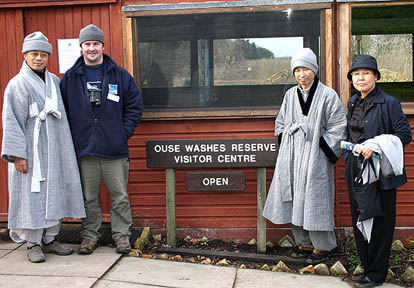
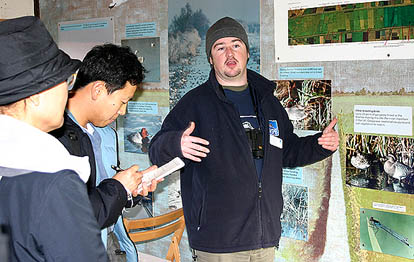
Korean Embassy, London a.m.
London Wetland Centre, WWT, Barnes p.m.
The Korean Embassy, London:

The Korean party, plus Graham Madge representing the RSPB, were warmly greeted by a delegation from the Korean Embassy which included the Korean Ambassador to the UK LEE Tae-sik, Ministers CHOI Jong-heub and KIM Il-soo, and Attache SUNG Chang-kee.
The scheduled 30 minute meeting ran for an hour. Whilst it is of course impossible to know whether such a meeting really could influence Korean policy towards Saemangeum, the views of both Birds Korea and the RSPB were respectfully listened to, and possible compromises to the reclamation project that had been brought up during the course of the week were discussed.
The London Wetland Centre, Barnes:
Developed by the Wildfowl and Wetlands Trust, Thames Water, and Berkeley Homes on the site of four redundant Victorian water reservoirs, the award winning London Wetland Centre is the first project of its kind in the world - more than 40 hectares of created wetlands in the heart of a capital city. The centre features a number of different "habitats", penned wildfowl, and a central lake fringed by reedbeds and wet grassland. Opened in May 2000, the London Wetland Centre now gives hundreds of thousands of visitors the chance to see rare and beautiful wetland wildlife just a stone's throw from central London. Go to: London Wetland Centre.
In February of 2002 the centre was designated a Site of Special Scientific Interest (SSSI), supporting nationally important numbers of Gadwall and Shoveler.
The group was warmly greeted by Centre Manager Stephanie Fudge, who introduced us to John Arbon, the Centre's Facilities Manager. An explanation of the concept behind the Centre was given, before John took the group on an extremely informative guided Tour of the wetland and its hides.
Kim Sukyung was interviewed at the Centre for a report on Saemangeum by the BBC World Service.
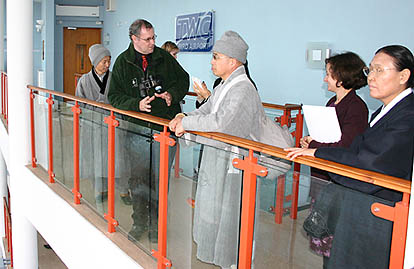
Photo © Charlie Moores/Birds Korea.
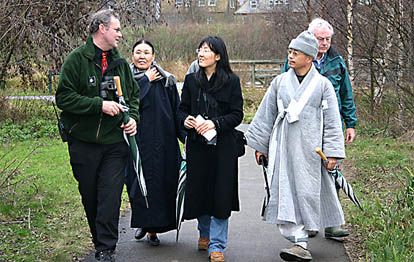

Photo © Charlie Moores/Birds Korea.
Comment:
The Korean party left the UK on February 3rd. The genuine respect and warmth that they were treated with made a very positive impression on them, and if the spirit of trust that was achieved can be maintained there has to be a real chance that this is the beginning of international cooperation between the fledgling Korean conservation movement and the UK.
The Birds Korea Network would like to thank the individuals and organisations who helped and supported this visit, and for the care that was taken to observe the cultural requirements of these distinguished guests.
Birds Korea 1108 Ho, 3 Dong, Samick Tower Apt., 148-22, Namcheon-Dong, Su-Young-Gu
Busan, 618-762 Republic of Korea



